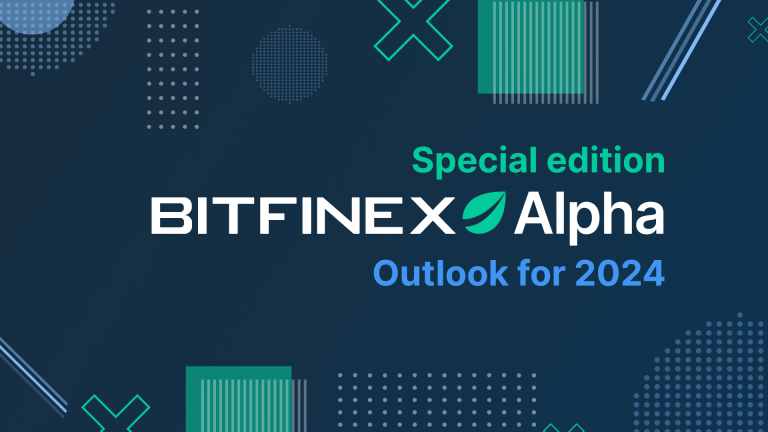December 28 Bitfinex Alpha| Bitcoin will rise in 2024, but not in a straight line
In Bitfinex Alpha
As we enter 2024, we remain very positive about the outlook for Bitcoin and crypto assets in general. If 2023 has proven anything, it is Bitcoin's remarkable resilience despite reputational and regulatory challenges.
This does not mean that the road will always win. Note that we are likely to see a bounce, based on historical market behavior. With the total cryptocurrency market value at approximately $1.6 trillion, we believe we could see the total market cap increase to $3.2 trillion, with asset values fluctuating within this range.
It is useful to look at different metrics and sentiment indicators and their performance at similar points in the cycle. Regarding the Cryptocurrency Greed and Fear Index, we expect that there is a high probability that we will see an extended visit to the “extremely greedy” psychological zone in 2024, which will be associated with a new BTC peak during the bull market.
As institutional investors increase their portfolios of crypto assets, with the long-awaited spot Bitcoin ETF being the catalyst, capital will likely shift to riskier crypto assets. And next year, but we expect institutional investment to continue to largely favor Bitcoin, at least until the first half of 2024.
In the short term, Bitcoin's market capitalization should be considered in relation to its actual value: the MVRV metric. Current assessments suggest that the market environment is similar to that of June 2019 and July 2016, which saw an initial decline in prices before a sustained recovery. This is another reason why we expect a bounce after identifying the $44,000-$45,000 area and why we expect the price to range further at these levels or rise immediately instead.
It is also important to monitor Bitcoin mining activity, especially since 2024 is the year of the halving and miners will ramp up their operations to make profits from selling Bitcoin on the market. Faced with the prospect of earning only half of what Bitcoin receives after the halving, miners will need to prove they can continue to run their operations efficiently and profitably.
Analysis by Puell Multiple indicates that the market is currently in a healthy state and there is plenty of scope for the price of Bitcoin to continue to rise with limited sales expected by miners.
Exchange flows from miners are also expected to continue to decline throughout most of the year even if we get some upsides in the next couple of months as miners upgrade more machines and sell Bitcoin to fund this investment. When prices rise, miners' selling demand will be limited.
The prospects for Bitcoin adoption in some major markets also look promising.
In El Salvador, where Bitcoin was declared legal in 2022, its adoption has continued to expand. We believe that as 2024 begins, the focus on enhancing the infrastructure to support Bitcoin transactions is likely to increase. This includes initiatives to raise awareness and educate the public about Bitcoin, especially among those who have been excluded from the formal banking system.
Perhaps most important is the growing acceptance of crypto assets by Argentines as a means of accessing relatively stable assets with no inflation. Even if Argentina is unlikely to follow the same path as El Salvador, the country's government still wants to bring economic stability to its people and sees value in decentralized assets like Bitcoin. Given the history of economic volatility, especially with high inflation rates, it is reasonable to expect that people will continue to turn to cryptocurrencies as a hedge against currency depreciation and inflation.
Looking ahead to 2024 and depending on market conditions, we expect the number of global cryptocurrency holders to rise to between 850 and 950 million (from the current 575 million).
In the broader macroeconomy, we also have positive prospects. Wage growth is likely to continue to slow in 2024. Workers may aim for a one-time wage adjustment to compensate for the unexpected rise in inflation that occurred in 2022, which pushed down real wages. However, this trend is expected to stabilize in 2024 as labor demand gradually declines. In the short term, we expect slower economic growth to push the unemployment rate higher, reaching an average of about 4.3% in 2024, compared to 3.7% in November 2023. However, this increase is relatively moderate compared to previous economic recessions. in the United States. .
Inflation rates are also expected to decline in 2024. A combination of factors, including a slowing global economy and more efficient supply chains, are expected to keep commodity prices stable, capping and supporting the manufacturing sector. The increased labor supply observed at the end of 2023 is likely to moderate wage growth, helping to keep inflation at manageable levels while weakening the connection to the labor market.
Core inflation, a key measure the Fed tracks as food and energy prices fluctuate, may fall below expectations due to tightening credit conditions and a weaker global economy. However, geopolitical tensions and the possibility of oil production cuts could pose increased inflation risks. Avoiding a recession by 2024 – a high possibility – does not guarantee a return to the ideal 2% inflation that central banks want. Market expectations indicate that annual inflation will return to 2.9% at the end of next year and is unlikely to decline further.
We are happy to offer you our views and analysis of the market. We hope you find it useful. We look forward to a promising year 2024.
Wishing you a warm holiday season and happy trading!

